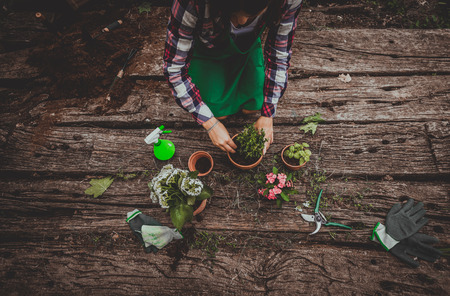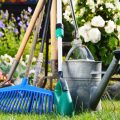1. Foundations of Zero-Waste Gardening
Zero-waste gardening is more than just a trend—its a thoughtful way to grow food and plants while caring for the environment. At its heart, this method focuses on reducing waste, reusing what we already have, and creating natural systems that take care of themselves over time. In this section, we’ll break down the essential principles that form the foundation of zero-waste gardening and explain how you can put them into practice in your own backyard.
Sustainability: Growing with the Future in Mind
Sustainability means making choices that support the health of our environment today and for generations to come. In gardening, this includes using organic methods, avoiding synthetic fertilizers or pesticides, and choosing native or drought-tolerant plants that require fewer resources.
Simple Sustainable Gardening Tips:
- Use compost instead of chemical fertilizers
- Collect rainwater for irrigation
- Plant perennials that return year after year
- Rotate crops to maintain healthy soil
Closed-Loop Systems: Nothing Goes to Waste
A closed-loop system in gardening is all about keeping materials and nutrients cycling within your garden rather than letting them go to waste. This means turning kitchen scraps into compost, saving seeds from your harvest, and using garden prunings as mulch.
Examples of Closed-Loop Gardening Practices:
| Waste Material | How It’s Reused |
|---|---|
| Vegetable Scraps | Composted into nutrient-rich soil |
| Fallen Leaves | Used as mulch or added to compost |
| Coffee Grounds | Mixed into compost or spread around acid-loving plants like blueberries |
| Eggshells | Dried and crushed to add calcium to soil |
Mindful Resource Use: Using Only What You Need
This principle is all about being intentional with the resources you use in your garden—like water, energy, tools, and even your time. Instead of buying new supplies every season, zero-waste gardeners repair tools, repurpose old containers as planters, and only plant what they can realistically care for.
Ways to Be More Resource-Conscious in Your Garden:
- Reuse pots, trays, and containers from past seasons
- Avoid single-use plastic products in gardening supplies
- Group plants with similar water needs together to reduce waste
- Create DIY trellises from sticks or reclaimed wood
Adapting Traditional Gardening for a Low-Waste Lifestyle
You don’t need to start from scratch to practice zero-waste gardening. Many traditional methods already align well with these principles. For example, Indigenous farming techniques like companion planting naturally reduce pests and improve soil health without chemicals. By blending old knowledge with new habits focused on sustainability and conservation, you can create a thriving garden that supports both people and planet.
As we continue through this guide, youll learn specific strategies for putting these foundational ideas into action—from composting techniques to eco-friendly garden planning. With each step, youll move closer to a truly zero-waste garden.
2. Composting: Turning Scraps into Soil
Composting is one of the most effective and accessible ways to reduce garden waste while enriching your soil naturally. Whether you have a spacious backyard or a compact urban balcony, composting can fit into your lifestyle and play a vital role in your zero-waste gardening journey.
Why Composting Matters
Every year, millions of tons of food scraps and yard waste end up in landfills across the U.S., where they contribute to methane emissions—a powerful greenhouse gas. Composting at home helps divert this waste and turns it into nutrient-rich soil that feeds your plants and improves soil structure.
The Science Behind Composting
Composting is a natural decomposition process driven by microorganisms, moisture, oxygen, and the right balance of carbon and nitrogen materials. These elements work together to break down organic matter into humus—a dark, crumbly soil amendment that supports plant health.
Carbon (Browns) vs. Nitrogen (Greens)
Achieving the right balance between carbon-rich “browns” and nitrogen-rich “greens” is key for successful composting. Heres a quick reference:
| Carbon-Rich Materials (Browns) | Nitrogen-Rich Materials (Greens) |
|---|---|
| Dried leaves | Fruit & vegetable scraps |
| Shredded newspaper | Coffee grounds |
| Sawdust (untreated wood) | Grass clippings |
| Cardboard pieces | Plant trimmings |
What Not to Compost
Avoid adding items that may attract pests or introduce pathogens:
- Meat, bones, or dairy products
- Oily foods or greasy leftovers
- Synthetic materials or plastics
- Treated wood sawdust or glossy paper
- Pet waste from carnivorous animals
Composting Methods for Any Space
Backyard Compost Pile or Bin
If you have outdoor space, a compost pile or bin is simple to set up. Turn the pile every 1–2 weeks to aerate and speed up decomposition. Keep it moist—like a wrung-out sponge—for optimal microbial activity.
Tumbler Bins
Tumblers are enclosed bins mounted on a stand that make turning your compost easy and mess-free—ideal for suburban backyards.
Bokashi Buckets (Fermentation Method)
This method uses beneficial microbes to ferment food scraps in an airtight container. It’s odor-free and perfect for small apartments. After fermentation, the material can be buried in soil to complete decomposition.
Vermicomposting (Worm Bins)
Using red wiggler worms to break down food scraps is another great option for indoor composting. Worm bins are compact, low-maintenance, and produce nutrient-rich worm castings.
Troubleshooting Common Issues
| Problem | Possible Cause | Solution |
|---|---|---|
| Bad odor (rotten smell) | Too much green material or poor aeration | Add more browns and turn the pile regularly |
| Pile not heating up | Lack of nitrogen or moisture; small pile size | Add greens, water lightly, and increase volume if needed |
| Pests attracted to pile | Food scraps exposed or wrong materials added | Bury scraps under browns; avoid meat/dairy/oily foods |
| Pile too wet or soggy | Poor drainage or excess water from rain/greens | Add dry browns like leaves or shredded paper; cover during rainstorms |
Getting Started Today
You don’t need fancy equipment to begin composting—just start saving your food scraps in a container and choose a method that fits your space. Over time, you’ll reduce household waste and create black gold for your garden. Composting is a small habit with big impact!
![]()
3. Water Conservation Techniques
Water is one of our most precious resources, especially in the garden. Whether youre in a drought-prone area or simply want to reduce your environmental impact, using smart water-saving methods is key to zero-waste gardening. Here are some practical and effective strategies you can use to conserve water while keeping your garden thriving.
Rainwater Harvesting
Collecting rainwater is an excellent way to reduce dependency on municipal water supplies. Set up rain barrels beneath downspouts to capture runoff from your roof. This water can be used for irrigation during dry spells. Just make sure to cover the barrels with lids or mesh screens to keep out debris and mosquitoes.
Benefits of Rainwater Harvesting:
- Reduces stormwater runoff
- Cuts down on water bills
- Provides plants with natural, untreated water
Drip Irrigation Systems
Unlike sprinklers that spray water over large areas (often wasting water through evaporation and runoff), drip irrigation delivers water directly to the root zone of plants. This method is not only efficient but also helps prevent weeds by limiting moisture where its not needed.
Drip vs. Sprinkler Irrigation
| Feature | Drip Irrigation | Sprinklers |
|---|---|---|
| Water Efficiency | High | Low to Moderate |
| Evaporation Loss | Minimal | High |
| Installation Cost | Moderate | Low to Moderate |
Drought-Tolerant Plant Selection
Selecting native and drought-resistant plants can greatly reduce your need for supplemental watering. Many of these plants have deep root systems and are adapted to thrive in local conditions with minimal care.
Examples of Drought-Tolerant Plants (U.S. Zones)
| Plant Name | Hardiness Zone |
|---|---|
| Lavender | 5–9 |
| Sedum (Stonecrop) | 3–9 |
| Echinacea (Coneflower) | 3–9 |
| Sage (Salvia) | 4–10 |
The Power of Mulching
A layer of mulch—such as shredded bark, straw, or compost—helps retain soil moisture by reducing evaporation, suppressing weeds, and regulating soil temperature. Organic mulches also enrich the soil as they break down over time.
Tips for Effective Mulching:
- Apply 2–4 inches of mulch around plants but keep it a few inches away from stems or trunks.
- Avoid dyed or synthetic mulches if youre aiming for a fully zero-waste approach.
By integrating these techniques into your gardening routine, you’ll not only save water but also create a more resilient and eco-friendly landscape that aligns with the core principles of zero-waste gardening.
4. Upcycled and Sustainable Garden Tools
Zero-waste gardening isnt just about composting and water conservation — it also includes using tools, containers, and materials that are sustainable or repurposed. Instead of buying brand-new plastic tools or disposable items, you can build your garden toolkit with upcycled materials that are both eco-friendly and budget-conscious.
Why Choose Upcycled Tools?
Repurposing old items reduces landfill waste, lowers carbon emissions from manufacturing, and saves money. Many everyday household items can be creatively transformed into useful gardening gear without sacrificing functionality.
Creative DIY Ideas for Garden Tools & Materials
Here are some simple and fun ways to incorporate upcycled items into your garden:
| Item to Repurpose | New Use in the Garden |
|---|---|
| Old kitchen utensils (e.g., forks, spoons) | Plant markers or mini rakes |
| Mason jars or glass containers | Mini greenhouses for seedlings |
| Busted garden hose | Cushioned grips for tool handles |
| Pallet wood | Raised beds, compost bins, or trellises |
| Tin cans | Herb planters or scoops for soil and compost |
| Torn jeans or old clothes | Kneeling pads or plant ties |
Sourcing Sustainable Garden Tools
If youre looking to buy instead of DIY, consider these tips for choosing more sustainable options:
- Bamboo-handled tools: Bamboo grows quickly and is a renewable resource.
- Stainless steel blades: Durable and recyclable at end-of-life.
- Secondhand shops: Thrift stores often carry gently used tools at lower prices.
- Locally made products: Support small businesses and reduce shipping emissions.
Tips for Maintaining Long-Lasting Tools
The longer your tools last, the less you need to replace them. Here’s how to extend their lifespan:
- Clean after use: Remove dirt and moisture to prevent rust.
- Sanding & oiling wooden handles: Keeps them smooth and splinter-free.
- Shelter storage: Store tools in a dry place like a shed or garage.
A Community Effort
You don’t have to go it alone! Join local gardening groups, online forums, or community swaps where members share tools, trade seeds, or exchange DIY ideas. Working together helps reduce costs and builds a stronger zero-waste culture in your neighborhood.
If you start seeing potential in everyday objects rather than tossing them out, your garden becomes not only greener but also more creative and personal. Upcycling isnt just practical—its empowering!
5. Long-Term Benefits for You and the Planet
Zero-waste gardening isn’t just a trendy practice—it’s a lifestyle choice that can bring lasting rewards. From improving your personal well-being to protecting the planet, the benefits grow along with your garden. Let’s explore how your zero-waste efforts create positive change over time.
Healthier You
By growing your own food without synthetic chemicals and reducing waste, you’re making healthier choices for yourself and your family. Eating fresh, homegrown produce means fewer preservatives and more nutrients on your plate. Plus, working in the garden keeps you physically active and reduces stress—good for both body and mind.
Financial Savings Over Time
While setting up a zero-waste garden might require a bit of upfront effort, the long-term savings are significant. Youll spend less on groceries, fertilizers, and waste disposal. Composting kitchen scraps and using natural pest control methods cut costs while closing the loop on household waste.
| Area | Traditional Gardening | Zero-Waste Gardening |
|---|---|---|
| Fertilizer Costs | $50–$100/year | $0 (compost-based) |
| Pest Control | $30–$75/year | $0–$10 (natural solutions) |
| Produce Expenses | $500+/year | $100–$200/year (seeds & supplies) |
Biodiversity Boost
A zero-waste garden encourages diverse plant life and invites beneficial insects, birds, and pollinators into your space. By planting native species and avoiding harmful chemicals, you support local ecosystems and help maintain balance in nature.
Your Garden as a Mini-Ecosystem
- Pollinators: Attracted by flowering plants; essential for food production
- Lizards & birds: Natural pest control allies
- Diverse plants: Improve soil health and reduce disease spread
Sustainable Soil Health
Your composting efforts feed the soil, not just the plants. Healthy soil holds water better, reduces erosion, and stores carbon—making it a powerful tool against climate change. Over time, this leads to more productive gardens with fewer inputs needed from outside sources.
A Healthier Community
Your zero-waste gardening habits can inspire others in your neighborhood. Sharing extra produce or composting tips strengthens community bonds. If enough people adopt similar practices, entire communities benefit from reduced landfill waste, cleaner air, and greater food security.
The Ripple Effect of Your Garden
- You: Save money, eat better, feel better
- Your Yard: Becomes a haven for wildlife and pollinators
- Your Neighborhood: Learns from your example and gets greener together


